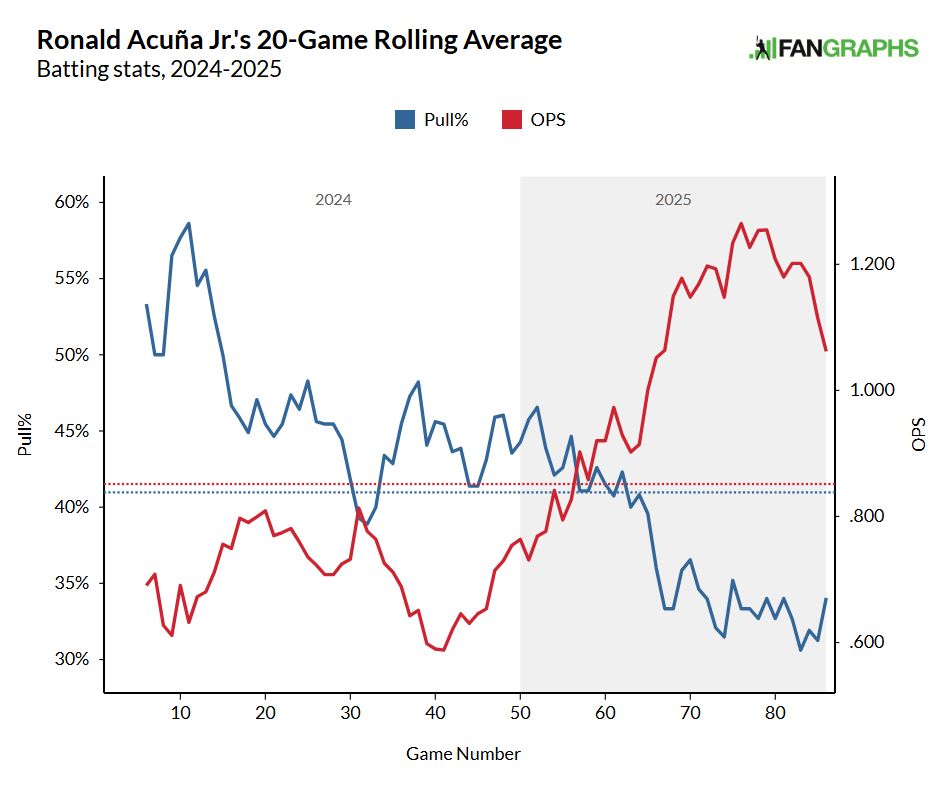Thirteen months ago, Ronald Acuña Jr. underwent surgery for a complete tear of the ACL in his left knee.
In 10 days, he’ll start the All-Star Game at Truist Park in Atlanta, joining Chipper Jones (2000) and Hank Aaron (1972) as the only Braves to start the All-Star Game in front of their home crowd. He'll compete in the Home Run Derby, too.
It’s a remarkable turnaround, with Acuña quickly re-establishing himself as one of the game’s truly elite players. Only Aaron Judge, Cal Raleigh, and Max Muncy have a higher wRC+ since May 23, the day Acuña made his season debut.
Highest wRC+ since May 23
Min. 70 PA (274 hitters)
- Aaron Judge (NYY): 211
- Cal Raleigh (SEA): 195
- Max Muncy (LAD): 194
- Ronald Acuña Jr. (ATL): 191
- Ketel Marte (AZ): 186
Acuña has been so good that it’s easy to forget how much he struggled the last time we saw him, in the early months of the ‘24 season. In 49 games before tearing his ACL, Acuña posted a .716 OPS and a 105 wRC+, both career-worst marks. He was just barely better than league average.
“I don’t know if it’s timing [of the swing] or not, but right now, I’m not that good,” Acuña said last May.
So how did he rediscover his MVP form in a 14-month span, while sidelined by a massive surgery? He’s simply gotten back to doing what he does best.
All stats below are updated through Thursday.
That starts with hitting the ball exceptionally hard. Acuña’s career barrel rate -- 14.8% -- is the 17th-highest in the Majors since his rookie season in 2018, among players with at least 500 PA in that span. His hard-hit rate -- 51.1% -- is 12th-highest.
After posting surprisingly poor contact quality in ‘24, Acuña is punishing the baseball like he usually does.
Acuña's quality of contact, '24 vs. '25
Barrel rate: 9.4% to 17.0%
Hard-hit rate: 48.2% to 54.5%
xSLG: .427 to .560
It’s worth noting that, even in a down year, Acuña still made a lot of hard contact -- his barrel rate and hard-hit rate were each better than the league average. Yet he didn’t have the same sort of success on those batted balls.
In 2024, the league hit .490 and slugged .966 on hard-hit contact -- batted balls with an exit velocity of 95+ mph, because that’s the threshold where exit velocity really begins to matter. Acuña, meanwhile, had a .433/.701 BA/SLG combo on hard-hit contact, which isn’t as good as it may initially seem, mostly because he struggled to lift the ball. That’s not the case in 2025.
Acuña's batted ball profile, '24 to '25
GB%: 51.8% to 43.2%
AIR%: 48.2% to 56.8%
Acuña didn’t have enough plate appearances last season to qualify, but for the sake of context: Only eight qualified hitters have seen a larger decrease in ground ball rate from 2024 to 2025 than Acuña (-8.6%). Likewise, only eight hitters have increased their fly ball rate at a higher clip (+7.9%).
There’s something else happening here, too.
Acuña has stopped pulling the ball. His pull rate (31.8%) is easily the lowest of his career. Typically, that’s not a great strategy: In a vacuum, hitters do the most damage when they catch the ball out in front, tapping into their pull-side power. Except, in Acuña’s case, the chart below is pretty convincing, even with a recent slump.

Over the last two seasons, he’s been a more productive hitter when he isn’t trying to pull the ball. Why? For one, last season, too much of his pull-side contact came on the ground; his Pull GB% -- 28.1% -- was one of the highest rates in the league, among hitters with at least 200 PA. That’s down to just 17.0% this season, which means that far fewer of his batted balls are ground balls to the pull side.
Perhaps more importantly, Acuña benefits from tremendous all-fields power. It’s encouraging that he’s using the middle of the field as often as anyone -- 50.0% of the time, the second-highest rate among hitters with at least 100 swings this season (trailing only his brother, Luisangel).
Elite bat speed (76.0 mph) affords him the ability to let the ball travel deeper; he can be a little late and still get the barrel around, driving the ball with authority from gap to gap.
Highest SLG on non-pulled batted balls, 2025
Min. 20 non-pulled batted balls
- Aaron Judge (NYY): 1.114
- James Wood (WSH): .908
- Nick Kurtz (ATH): .878
- Shohei Ohtani (LAD): .861
- Kyren Paris (LAA): .838
- Ronald Acuña Jr. (ATL): .817
That’s another strength of Acuña’s that disappeared in 2024: He slugged just .556 on non-pulled batted balls.
So, what changed? Recall Acuña’s quote from last May: “I don’t know if it’s the timing [of the swing or not].” Statcast’s latest swing metrics can, to a certain extent, verify this for us.
Acuña returned from injury with a slightly different swing -- he has a bit more of an uppercut and, relevantly, is better suited to lean into his natural all-fields power.
Attack Direction measures the horizontal angle at which the barrel of the bat is moving when it makes contact with the ball; it’s shown in degrees “pull” or “oppo.” At 8°, Acuña has one of the more oppo-oriented swings in the Majors, among right-handed hitters. That’s up from his 5° Attack Direction in ‘24; only a handful of qualified hitters have developed a more “oppo” Attack Direction from ‘24 to ‘25 than Acuña.
That’s not a binary good or bad -- just a way to describe a player’s style of hitting. But it certainly seems like a direct counter to the struggles that plagued him in ‘24, especially considering that Attack Direction is really just a timing metric.
How do we know that Acuña’s timing is right again? It starts with the fastball: Only nine of 379 qualifying hitters have a higher SLG on fastballs this season (min. 50 PA ending on fastballs).
Against velocity -- pitches thrown 95 mph or faster -- Acuña is running a BA/SLG combo of .290/.548. In 2024, he hit just .205 with a .295 SLG against that same subset of pitches. He couldn’t hit velocity, and it wasn’t a matter of swing-and-miss: His whiff rate against pitches thrown 95 mph or faster in 2025 (34.2%) is higher than his whiff rate against those same pitches in 2024 (29.4%).
What it is, then, is a matter of timing -- of getting the barrel onto the ball at the right angle.
Acuña needed just one pitch in the Majors this season to show that he had fixed his ‘24 woes. On May 23, he stepped to the plate at Truist Park and received a first-pitch fastball from San Diego’s Nick Pivetta. He hammered it out to left-center field for a titanic 467-foot home run. It’s the fifth-longest home run of Acuña’s accomplished Major League career.
And he hasn’t slowed down since.
